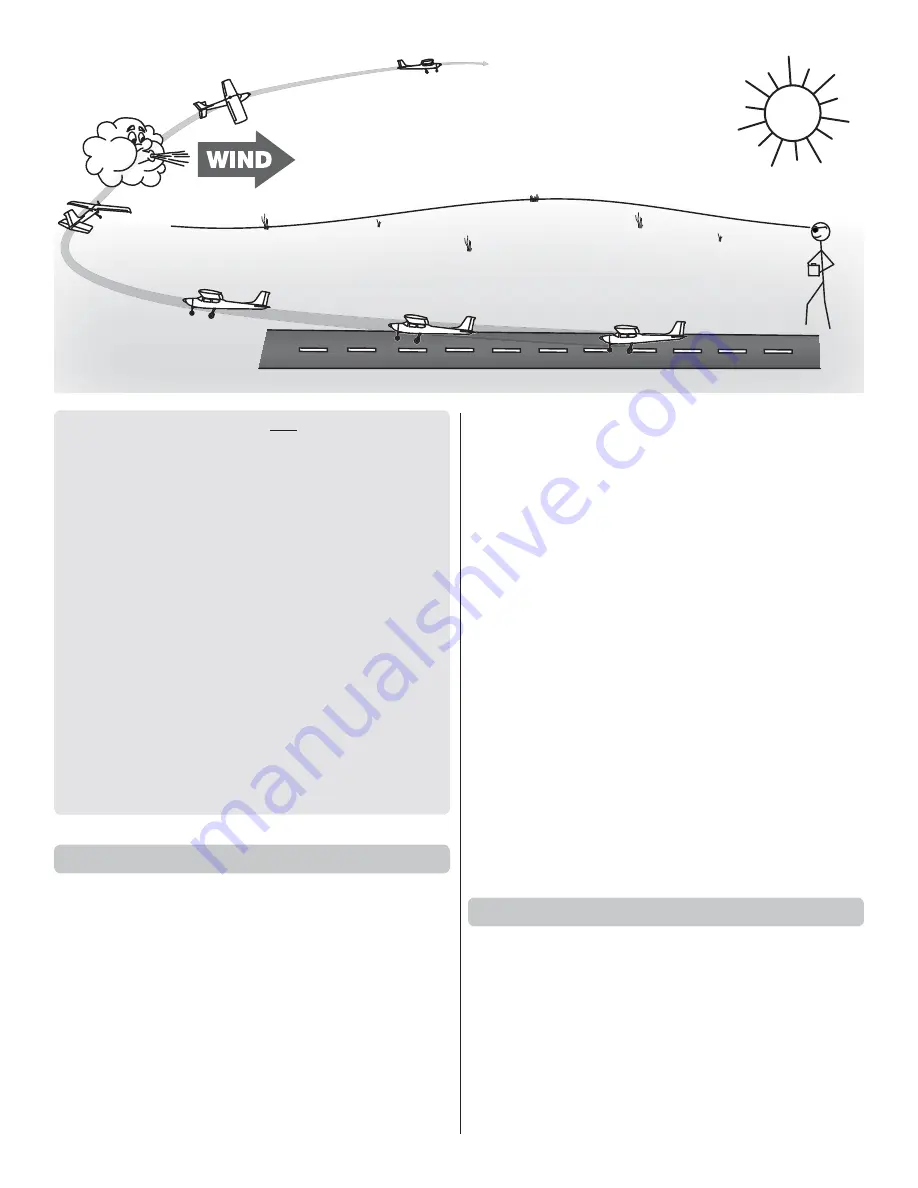
18
CAUTION
(THIS APPLIES TO ALL R/C AIRPLANES): If,
while fl ying, you notice an alarming or unusual sound such as
a low-pitched “buzz,” this may indicate control surface
fl utter.
Flutter occurs when a control surface (such as an aileron or
elevator) or a fl ying surface (such as a wing or stab) rapidly
vibrates up and down (thus causing the noise). In extreme
cases, if not detected immediately, fl utter can actually cause
the control surface to detach or the fl ying surface to fail, thus
causing loss of control followed by an impending crash. The
best thing to do when fl utter is detected is to slow the model
immediately
by reducing power, then land as soon as safely
possible. Identify which surface fl uttered (so the problem
may be resolved) by checking all the servo grommets for
deterioration or signs of vibration. Make certain all pushrod
linkages are secure and free of play. If it fl uttered once, under
similar circumstances it will probably fl utter again unless the
problem is fi xed. Some things which can cause fl utter are;
Excessive hinge gap; Not mounting control horns solidly; Poor
fi t of clevis pin in horn; Side-play of wire pushrods caused
by large bends; Excessive free play in servo gears; Insecure
servo mounting; and one of the most prevalent causes of
fl utter; Flying an over-powered model at excessive speeds.
Takeoff
Before you get ready to take off, see how the Sensei handles
on the ground by doing a few practice runs at
low speed
on
the runway. Note the amount of rudder steering required to
turn the plane. If you need to calm your nerves before the
maiden fl ight, bring the plane back to the pits, unplug and
remove the battery and peak charge it.
It is best to make the fi rst couple of fl ights with the sun at
your back. With the sun directly overhead the bottom of the
plane is in shadow and can sometime confuse the beginner
pilot. Do not take the fi rst fl ights with the sun in front of you.
Experienced pilots that have better control of the plane can
avoid fl ying into the sun.
The WISE gyro stabilization system will automatically add the
necessary up elevator to lift off the runway and begin to climb
to a safe altitude. You will have control to easily pull down on
the right stick to add a bit more elevator to increase your rate
of climb on take off if necessary. With that in mind, your main
focus is to use the rudder to steer the plane into the traffi c
pattern (the direction that the other modelers are fl ying their
planes) once you get into the air.
Be sure the mode switch is in BEGINNER mode and you have
the dual rate switch set to LOW. Taxi the Sensei out onto the
runway and line it up with your intended takeoff direction. Be
sure you are taking off into the wind. If there is very little or no
wind then plan your fl ight away from the glare of the sun. When
you’re ready, advance the throttle to full. You don’t need to slam
the stick all the way up. A smooth transition that takes a moment
or two will give your refl exes a chance to pull the throttle back if
the plane gets off track or there is something else alarming. Be
prepared to make small corrections with the rudder to keep its
takeoff path straight, just as if you were to steer an automobile on
a highway. You’ll see the plane get “light” on the wheels. Then it will
lift off and begin to climb. At full throttle the Sensei will continue
to gain altitude. If you feel the plane is not climbing fast enough,
gently apply some up elevator by pulling down on the elevator
stick. Focus on steering the plane with the rudder. Plan for a wide,
circular fl ight path in only one direction for your fi rst fl ight or two.
Flight
Now that you are at a safe fl ying altitude (not so high that you
have a hard time seeing the plane), reduce the throttle to half
and relax a little. With the Sensei in BEGINNER mode the
WISE gyro will stabilize your fl ight and minimize the chance of
you becoming disoriented and losing control of the plane. At
half throttle the plane should no longer be climbing but rather
maintaining a level altitude. Maintaining the same direction
during your fi rst few fl ights will get you accustomed to the
plane appearing to respond in the opposite direction of your
rudder or aileron input when the plane is fl ying toward you.
Remember- You should always steer the plane as if you were
TAKEOFF



































